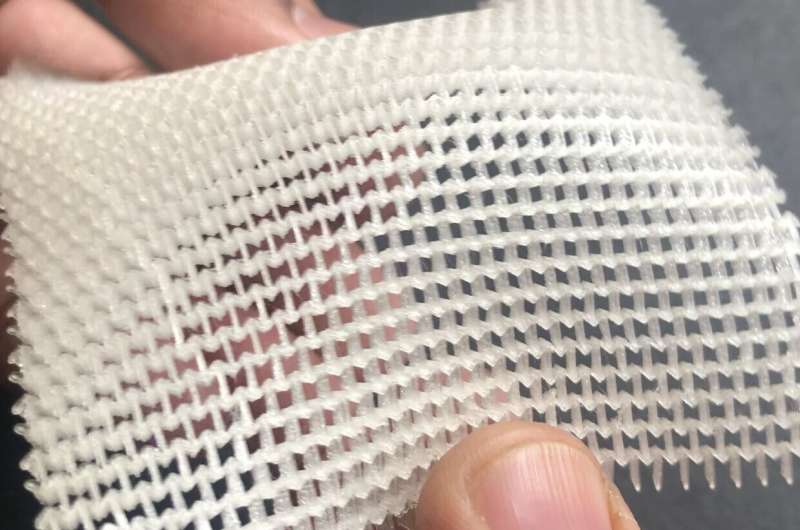A textile engineer at Heriot-Watt University has developed a new material to boost flexibility and comfort of personal protective equipment (PPE).
Traditional protective clothing is often made from foam to absorb impact but this comes at a cost of reduced mobility. To overcome this limitation, Dr. Saadullah Channa based at the School of Textiles and Design (SOTD) in Galashiels, in the Scottish Borders, has used 3D printing to create a soft material from a single flexible resin arranged in a re-entrant honeycomb structure as an alternative to foam.
Unlike conventional hexagonal honeycombs, a re-entrant honeycomb structure features inwardly protruding cell walls. This unique geometry gives it auxetic properties, meaning that when stretched in one direction, it expands rather than contracts, and when impacted, the structure contracts rather than expands—enhancing both flexibility and resistance.
Initial tests of the material, known as a 3D-printed auxetic structure, have been promising. A 5mm layer provides approximately three times greater impact protection than the same thickness of traditional foam. Importantly, it also flexes in all directions, allowing for greater comfort and mobility without sacrificing safety.
Dr. Channa says that although the primary purpose of his research is to improve the ergonomics of sportswear, it also holds huge potential for applications in other sectors, including health care.
Dr. Channa carried out the work for his Ph.D. He said, “I was looking for a material that could reduce foam thickness while improving impact resistance. My research indicates that 3D-printed re-entrant honeycomb cellular structures have significant potential for PPE applications, helping to prevent impact injuries to the knees, hips, elbows, and shoulders. This structure ensures comfort, enables natural body movements, and provides an impact-resistant solution.”
Polyurethane is commonly used in protective foam. Tiny bubbles harden to form a robust structure capable of absorbing impact. Traditional foam can, however, be bulky and often combined with harder materials to improve durability.
Dr. Channa discovered that by structuring a similar polyurethane-based flexible resin into a re-entrant honeycomb pattern, he could achieve a greater level of protection at a reduced thickness, significantly improving mobility.

A series of experiments were carried out at the Galashiels campus where sensors were used to measure the forces transmitted through the material upon impact. The results revealed exceptional energy absorption, confirming the effectiveness of the auxetic structure.
Dr. Channa added, “When the results came back, it was hugely exciting. This approach could revolutionize the design of protective wear, making it more comfortable without compromising on safety.”
This study is believed to be among the first to explore both the mobility and impact resistance of an auxetic material, paving the way for more advanced applications in protective clothing.
Dr. Channa intends to work with industry, including high profile sports brands, to bring his material to market.
Dr. Danmei Sun, Associate Professor in Textile Materials and Technology at the School of Textiles and Design and academic supervisor of the research, said, “Dr. Channa’s groundbreaking Ph.D. research on 3D-printed honeycomb structures with active-responding impact performance has the potential to transform the PPE sector.
“It offers an alternative to conventional protective foams. The discovery enhances both flexibility and impact resistance, balancing safety with mobility. By reducing material thickness while improving energy absorption, this innovation could lead to more comfortable protective gear for industries such as health care, sports, and emergency response.”
Citation:
Textile engineer develops 3D-printed material to boost mobility in protective clothing (2025, June 1)
retrieved 1 June 2025
from https://techxplore.com/news/2025-02-textile-3d-material-boost-mobility.html
This document is subject to copyright. Apart from any fair dealing for the purpose of private study or research, no
part may be reproduced without the written permission. The content is provided for information purposes only.

